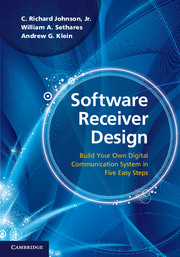Book contents
- Frontmatter
- To the Instructor …
- Contents
- Dedication
- Step 1 The Big Picture
- Step 2 The Basic Components
- Step 3 The Idealized System
- 4 Modeling Corruption
- 5 Analog (De)modulation
- 6 Sampling with Automatic Gain Control
- 7 Digital Filtering and the DFT
- 8 Bits to Symbols to Signals
- 9 Stuff Happens
- Step 4 The Adaptive Components
- Step 5 Putting It All Together
- Appendices
- Index
- References
4 - Modeling Corruption
from Step 3 - The Idealized System
Published online by Cambridge University Press: 05 June 2012
- Frontmatter
- To the Instructor …
- Contents
- Dedication
- Step 1 The Big Picture
- Step 2 The Basic Components
- Step 3 The Idealized System
- 4 Modeling Corruption
- 5 Analog (De)modulation
- 6 Sampling with Automatic Gain Control
- 7 Digital Filtering and the DFT
- 8 Bits to Symbols to Signals
- 9 Stuff Happens
- Step 4 The Adaptive Components
- Step 5 Putting It All Together
- Appendices
- Index
- References
Summary
If every signal that went from here to there arrived at its intended receiver unchanged, the life of a communications engineer would be easy. Unfortunately, the path between here and there can be degraded in several ways, including multipath interference, changing (fading) channel gains, interference from other users, broadband noise, and narrowband interference.
This chapter begins by describing some of the funny things that can happen to signals, some of which are diagrammed in Figure 4.1. More important than locating the sources of the problems is fixing them. The received signal can be processed using linear filters to help reduce the interferences and to undo, to some extent, the effects of the degradations. The central question is how to specify filters that can successfully mitigate these problems, and answering this requires a fairly detailed understanding of filtering. Thus, a discussion of linear filters occupies the bulk of this chapter, which also provides a background for other uses of filters throughout the receiver, such as the lowpass filters used in the demodulators of Chapter 5, the pulse-shaping and matched filters of Chapter 11, and the equalizing filters of Chapter 13.
When Bad Things Happen to Good Signals
The path from the transmitter to the receiver is not simple, as Figure 4.1 suggests. Before the signal reaches the receiver, it may be subject to a series of strange events that can corrupt the signal and degrade the functioning of the receiver.
- Type
- Chapter
- Information
- Software Receiver DesignBuild your Own Digital Communication System in Five Easy Steps, pp. 59 - 79Publisher: Cambridge University PressPrint publication year: 2011



